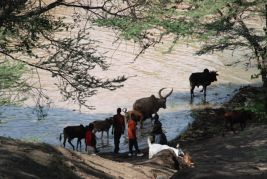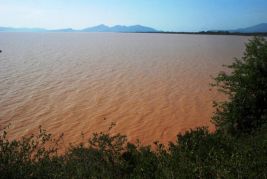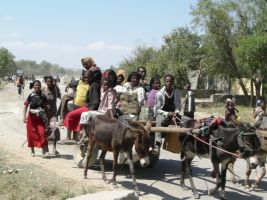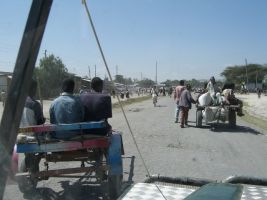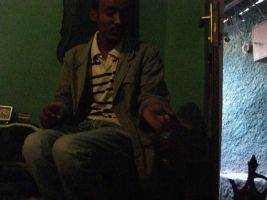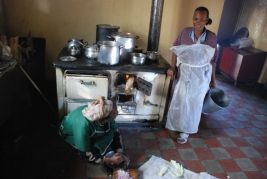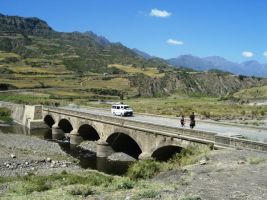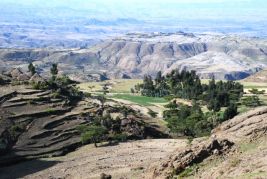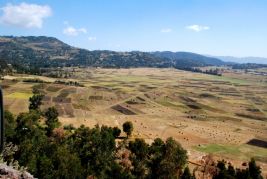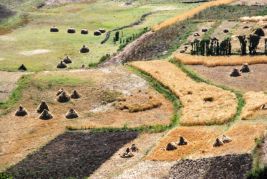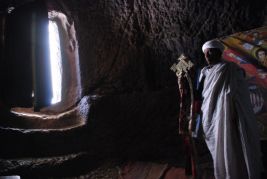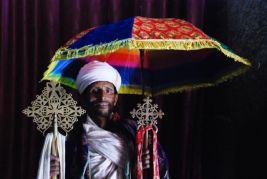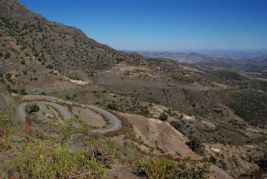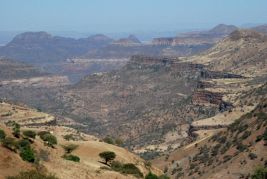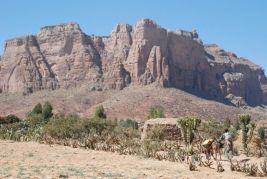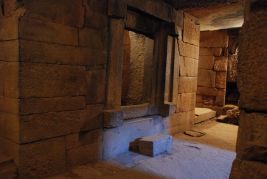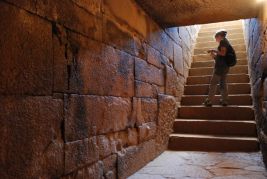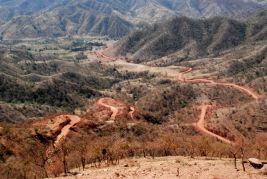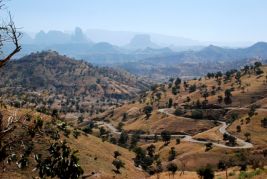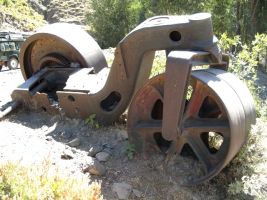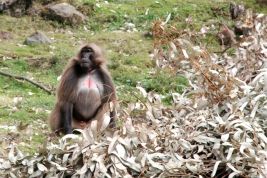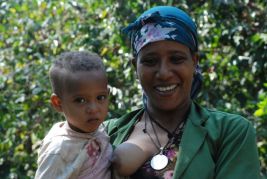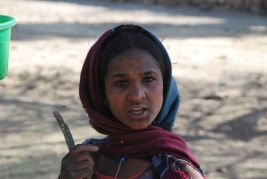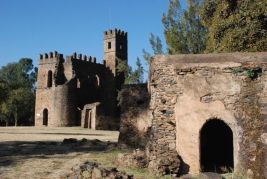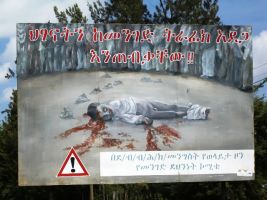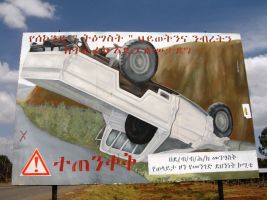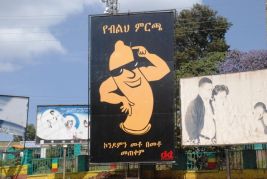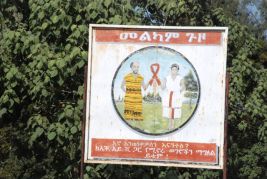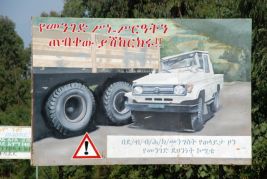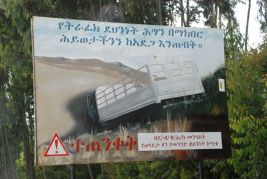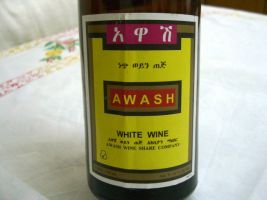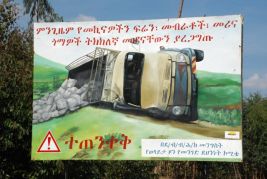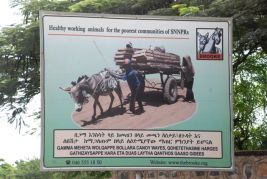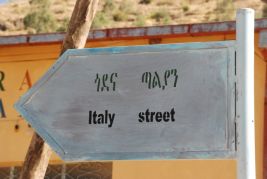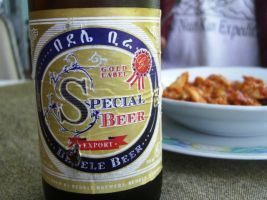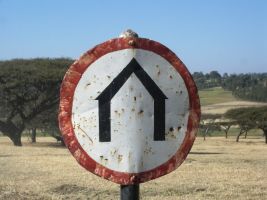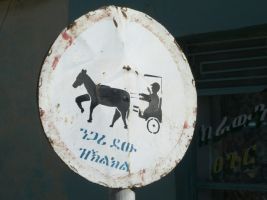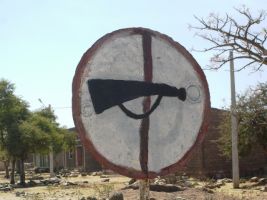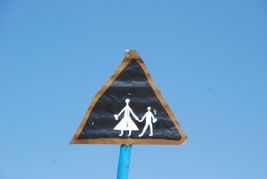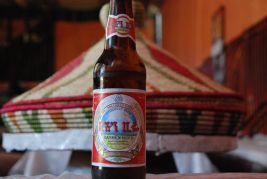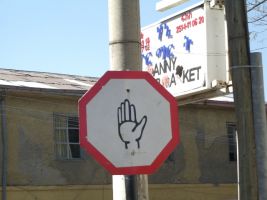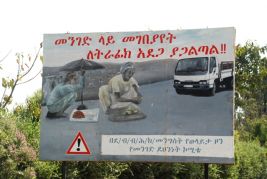
 Italia
Italia France
France Spain
Spain Morocco
Morocco Mauritania
Mauritania Senegal
Senegal Mali
Mali Burkina
Burkina Ghana
Ghana Togo
Togo Benin
Benin Nigeria
Nigeria Cameroon
Cameroon Gabon
Gabon Sao Tomè
Sao Tomè Gabon 2
Gabon 2 Congo
Congo Congo DCR
Congo DCR Angola
Angola Namibia
Namibia Sud Africa
Sud Africa Namibia 2
Namibia 2 Botswana
Botswana Zimbabwe
Zimbabwe Botswana 2
Botswana 2 Sud africa 2
Sud africa 2 Swaziland
Swaziland Mozambico
Mozambico Malawi
Malawi Tanzania
Tanzania Rwanda
Rwanda Uganda
Uganda Kenya
Kenya Etiopia
Etiopia Sudan
Sudan Egitto
Egitto Libia
Libia Tunisia
Tunisia Malta
Malta

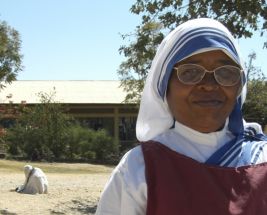

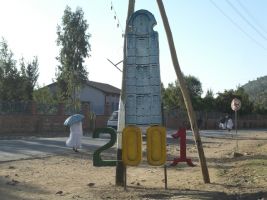
Border - 28 Nov 2008
The exit from Kenya is quick and without problems. A swift check-up by the customs officers of the engine and chassis number of K7 and we are on our way. Very few people speak English here and their Amharic language is impossible to understand. I go back to driving on the right with some difficulty after seven months on the left. The habit of getting it wrong and going to the left is the same as it was months ago.
The country is much poorer than Kenya but the roads are definitely better. We travel along an old but smooth asphalted road; a relief for us and K7.
Their time is measured differently to the time our watches show.
Their time, is measured as it was in medieval times, therefore sunrise is at 1 o’clock. Midday is at 6 o’clock and sunset is at 12. The first hour of the night is once again 1, which corresponds to our 7 in the evening.
Interesting.
Entering Ethiopia is good for you.
You suddenly find yourself seven years younger! The Julian calendar that’s been used here since Julius Caesar shows us it’s 2001.
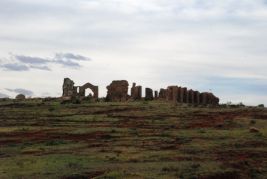
Italian Fortress
The first signs of an Italian presence in this land; colonizers, up until this point where nearly always French, Dutch, English or Portuguese; now it was the turn of Italians. It was towards the end of the thirties and from the nearby Eritrea, which was already an Italian colony since the beginning of the century, that an army of soldiers and Blackshirts crossed the boundaries an invaded the Nation. In this area south of the country, there are the remains of this fortress, a developed garrison towards the English Kenya of then.
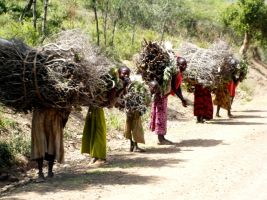
It is truly amazing what these women can carry on their backs.
Kilos and kilos of wood that they carry for miles and miles just for daily cooking.

Yavello – 28 Nov 2008
There is a sense that since leaving Kenya, we have now also left “Black Africa”.
The African “nobody-does-anything-unless-you-pay” mentality doesn’t seem to be present here in Yavello.
Ethiopia is renowned for its hospitality and has welcomed us from the offset.
The ever so kind Iwotte left us speechless by providing a safe place to camp, tea after sunset and surprising us with a plate of spaghetti with spicy tomatoes for breakfast.
Payment request – just a smile
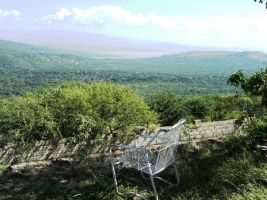
Arba Minch – 29 Nov 2008
This is the area of lakes and of tribes dedicated to their traditions.
With all the vibration, one of the supports for an internal wooden cupboard has broken. We make some improvised remedial works from some material I have with me. We replace fifteen or so rivets and I check all the fluid levels. The bonnet has cracked again and is touching the engine crushing the metal guard that protects the air conditioning compressor and by doing so, is chaffing the belt. I have a go at straightening it, but it will need fixing properly as soon as possible.
We stay to relax for a few days in the panoramic park of Bekele Mola Hotel and Restaurant.
GPS N06°00,300’ E37°33,106’

Giuliana, the gypsy
We met Giuliana from Turin in Ghana many months ago when we were travelling south. She was heading north to Italy. Now by coincidence, along the road, we see a white Toyota with a Venezuelan number plate. What a wonderful surprise to see her again! She is now travelling towards South Africa to sail to America with her car; she is travelling around the world. A true gypsy! Good luck!
Carts
They are slow and unpredictable and can be extremely dangerous.
There are so many of them everywhere, you never now which direction they’re going to take! Along with the herds of cows and sheep they own the roads. Often, you’ll come across them on a bend with the shepherd showing no interest in moving them.
Even the unforgiving truck drivers, the usual kings of the road in Africa have to slow down!
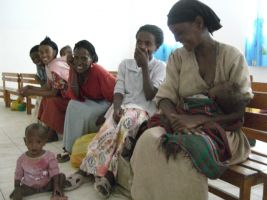
Ziway Mission
Passing by Ziway, we stop and see Sister Antonietta who we first met in Nairobi about two months ago. The mission is big and they have many projects helping the poor. There is a school for model makers, “high fashion” dressmakers as well as technicians in computers.
We leave an ELFO token (details in solidarity).
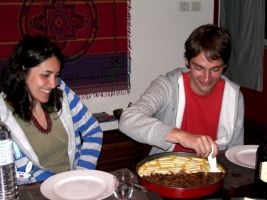
We’re in Addis Abeba – 8 Dec 2008
We are guests of the fabulous Marta and Fabio; they work here for an ONG called CIAI that takes care of, amongst other things, adoptions of minors.
We spend a few lovely days with them, continuously being chewed alive by there “lovely” dog Kali. We go to see an interesting jazz concert infused with flamenco and local music. We try a difficult Ethiopian dance based on rapid shoulder movements risking dislocation and muscle pulling.
We allow ourselves a lovely polenta though…
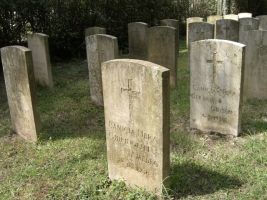
… we go to look for Granddad Giuseppe
Here in Addis, there is an Italian military cemetery. Buried here, are the soldiers that fell during the colonization in the fascist period between 1936 and December 1941; the English drove them out after the Second World War.
Grandpa Giuseppe lost his life here; it is for his granddaughter, a dear Italian friend of ours that we set out to find him.
Unfortunately after over an hour, we can’t find a tombstone with his name. There isn’t a register and so we will have to ask the Italian embassy if they have any news.

K7 – A whole day in the workshop!
We only needed to weld a steel bonnet support that we had put right in Namibia; it broke again going through Kenya.
Instead, we end up welding the cracked aluminium section as well as repainting the bonnet. The engine oil and three filters are changed; we check all the other oil and fluid levels; differential, gearbox, brakes, clutch and the power steering. Everything else is greased, the suspension is checked; still the same shock absorbers since we left Italy.
Then, we change the four rubber caps to the struts at the front - unfortunately one of the diagonal bolts was so badly seized, it had to be cut piece by piece with oxyacetylene; two frustrating hours. I have to say, they are very good and know what they’re doing. Ethio Lakes General Automotive Trading
Tel 251-11-4431492
GPS N08° 58.782’ E038° 45.353’

Lion of Judah
It is the symbol of the Ethiopian monarchy and was erected to mark the coronation of Hailè Selassiè in 1930. During the invasion in 1935, it was taken by the Italians to Rome where it was placed near the statue of Victorio Emanuele.
In Italy 1938, an Eritrean protester, kneeled before it in homage and in a protest of indignation. He was arrested by the police and kept in an Italian prison were he died seven years later.
In 1960, the lion was given back to the Ethiopian population and returned to Addis where it now sits in the middle of a flower garden in front of the train station.
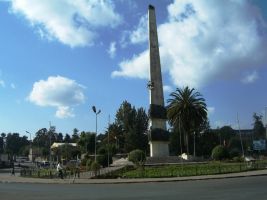
Yekatit 12, an Italian massacre
It seems that Marshal Graziani was well known for his curtness and heavy handed approach when dealing with the African people.
First in Libya and then in Ethiopia, his “impetuous” methods to rid rebels and the opposition were notorious.
In 1937, in Addis Abeba, an attempt was made to assassinate him during the distribution of money to the poor. The response that followed with the backing and approval of Mussolini in Rome was outrageous.
There were three days of slaughter during which time some thousands of Ethiopians died. Acts of retaliation by the Blackshirts in the city and mopping-up operations done in Scioa, the region where the Ethiopian opposition was more indomitable.
As often happens in these situations, it is the innocent that pay the price. A few years later, it was discovered that the assassination attempt had been organized by two young Eritreans (not Ethiopians!) who had a degree from an Italian school and worked for the land registry. This monument is to remember those that died during the massacre.
Coffee Ceremony
It is a very strong tradition.
When they have guests they burn some incenses, then they lightly toast the coffee grains whilst they sit on a rug of grass eating sweet pop-corn and oranges. Once the grains are toasted, they are finely ground on a wooden mortar, hot water is then added to the ground powder in a terracotta coffee pot over the hot embers.
Then they drink the first coffee; after, they recycle the ground coffee with more water and make a second pot followed by a third lighter one. After three coffees and an hour and a half of chatting the ceremony is finished.
We are all kindly invited to this ritual by the Mareg, a worker from the mechanic workshop.
He has a sister in Italy and he begs us to trace here and give her an Amharic-Italian dictionary.
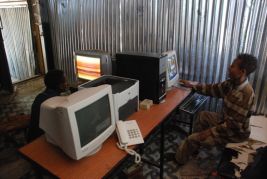
Internet Impossible
We thought that here in the capital we would finally be able to update the website and contact via email, the embassy and agencies and begin tackling Libyan bureaucracy. Instead, there are only a few internet points that actually work (Global hotel), and when it does, we only have email at our disposal. Skype is blocked by the government as well as all “dynamic” sites, which are those that can be updated online like ours. We can’t even see our website thanks to the “blog” block” - a way of exchanging messages and opinions over the net.
Outside the capital, getting access to electronic post is as good as impossible. When you do manage - about a one-in-three chance - it is very slow, you can only read and write emails if you have a lot of time on your hands.
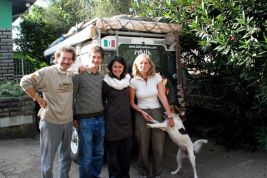
Solidarity and Goodbyes
Before leaving Fabio, Marta and Kali, we ask them to help us decide which local project to leave an ELFO token for.
We choose LIGA, a local project that has organized a nursery on the outskirts of Addis (details in solidarity).
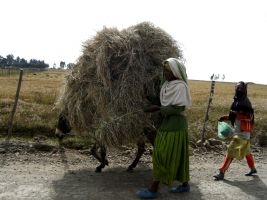
400km of road-works
Exiting the north of Addis, we head along the “historic” route.
The road-works make the journey slow and arduous...
Within a few years, travelling will be easier, but for now, we head on slowly.
As slow as the donkeys by the side of the road and sometimes in the middle, full of all sorts of goods.
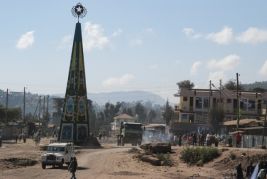
Dessie – 9 Dec 2008
We arrive after dark, with temperatures that are very low, even for mountain altitudes. We find shelter for the night in a mission run by local missionaries.
The building is very big and we pay a visit to the nurseries through to the college where there are students of all different religions. For those that come from far away, there is a male and female boarding school. In the picture, the kitchen during lunch preparation.
We leave an ELFO token (details in solidarity)
Spectacular View!
We are still on the hundreds of miles of road that was built by Italians during the occupation.
We cross many bridges and viaducts, the architecture of which is familiar. They blend in well in an area that just keeps getting more and more beautiful.
We climb the cold and windy plateau with breathtaking scenery. The terraces and subdivisions of small plots makes for a really interesting and fascinating landscape.
The cultivated fields are full of wonderful colours in this season of harvest.
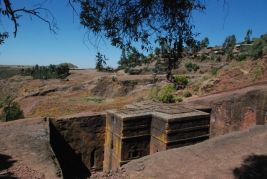
Lalibela – 10 Dec 2008
This is probably one of the most suggestive and important historic points in Ethiopia and in all of Africa. This site is one of three that represent very important historic moments. Churches dug out and built into the mountains; works dating back to 1200, by Lalibela, one of the Christian Kings that reigned in Ethiopia.
The religion is the old Orthodox Copt similar to Catholicism. One of the main features are the crosses. Each church has a different cross with its own symbolic meaning; some are in gold but most of them are in brass. A surprising place, protected by UNESCO.
The track that we continue along isn’t on our map or even on the GPS. It is very panoramic and we remain breathless at every turn. It continuously rises and dips; at times, it gives the impression of flying.
Grand Canyon or Africa? Dolomites or Ethiopia?

Mekellè – 12 Dec 2008
This place is famous for the vicissitudes connected to the fascist period; its name appears in a version of a traditional fascist song “Faccetta Nera”.
In fact, it was a fascist adaptation from an original text that was written in Roman dialect where this city wasn’t mentioned.
There is a small museum within the palace made for King Yohannes IV by an Italian architect in 1873. There is very little of interest compared to the actual building. Inside, in the corner, is a bust of Mussolini that was brought 50-years later to “brighten up” the place.

Rock Churches of Tigrai
In this area, there are more than one-hundred and twenty churches and Orthodox Coptic Christian monasteries built into the rock of the mountain. To reach some of them, you have to be able to climb like a professional with climbing ropes. Each church has an entrance fee and in the most remote ones, without a local guide (that is always just improvising), you risk facing a REAL stoning.
We decide to visit the Abraha Atsbeha, one of the most beautiful with well preserved paintings dating back to the 17th century.
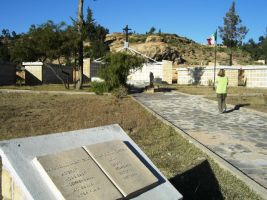
Adigrat – 13 Dec 2008
We know that there is a war cemetery here and we feel it only right that we go to see if granddad Giuseppe is here.
There are the graves of many soldiers that died during the first unsuccessful invasion at the beginning of the century, marked by a terrible defeat at Adwa.
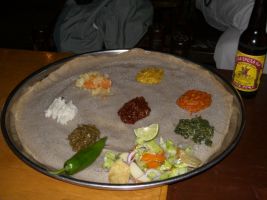
Injiera
A fixed menu for every meal. Like bread for Italians and Europeans alike, the “injiera” is the base of every Ethiopian meal; the injiera is laid on the plate like a bread “napkin” with the food placed on top, it is then broken with your hands and rolled together with the food inside. A single plate for all the different dishes; the meat and vegetables are often spicy and nearly always served with a sauce.
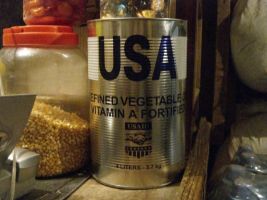
Help is being sold!!! – 14 Dec 2008
We are in Adwa.
By chance we meet Gualb, a lovely missionary from India; she follows the order of Mother Teresa. She shows us around the centre where for 23 years she’s been helping the poor, mentally disabled and those suffering from HIV and TBC. They also help over 1000 cases from outside the centre with the distribution of “dry” food (flour and cereal mixes).
At the moment the government holds 50% of the humanitarian help destined for these people donated by the leading international organizations in America.
Unfortunately we found these products being sold in shops, like this tin of oil.
We leave an ELFO token for the centre (details in solidarity)

Adwa, a sobering defeat! – 14 Dec 2008
The biggest defeat of any colonial army in all of Africa.
The biggest victory in the history of Africa of a population fighting against the colonization of their land.
It was on 1st March 1896, when more than six-thousand young Italian soldiers were killed in an epochal battle. The Italian army had been sent from Eritrea, a place that had already been a colony for 7-years. They were ill-prepared and suffering from malnutrition and consequently they were decimated. This military manoeuvre was ordered by Francesco Crispi’s government. This humiliating defeat brought about his resignation and taught them an unforgettable lesson that has made Ethiopia famous in Africa as “the nation that resisted its invaders”. Thousands of young Italians paid the ultimate price; young farmers and workers sent here for the glory of the Italian Kingdom. Those that did managed to survive, within twenty years were giving there lives in the filthy, squalid trenches of the First World War.
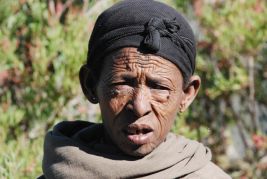
Association of Friends - Adwa
Simona from Central (Fe), Paolo from Castelfranco along with Emila and Michele are voluntary workers working at one of the splendid centres set-up by the Association of Friends - Adwa (www.amicidiadwa.org). This centre in Ethiopia is run by the very capable Sister Laura, with her family and other Sisters.
There is a nursery, primary school, secondary school and a college.
There is accommodation for students that have to travel, a school for needlework and tailoring and a very modern textile lab where following their education; students can then find a job in the nearby government packaging factory, just a few kilometres away.
To help promote self-sufficiency for the many poor families in the area, there is a stable and small farm with rabbits and aviculture. In addition, over two-thousand families are helped by distance adoption.
A project using greenhouses is picking up now but still isn’t fully functional.
Another initiative is the recycling of paper to produce combustible tiles that are distributed to families, to be used instead of wood which is rare and expensive.
We leave an ELFO token to the “For Woman” project (details in solidarity).

Axum – 15 Dec 2008
This is the oldest archaeological site in Ethiopia.
The old capital of the Axumita Kingdom dates back 2000-years, in the period of Jesus’ birth.
These monumental stelae were erected for many centuries until King Ezana embraced Christianity, around 320 A.D
As the greater ones, made from a single block started to topple, attempts were made to hoist them back into position, as they did so they would break and crumble; the people interpreted this as a sign of divine intervention and subsequently stopped.
As well as the stelae, we visit the remains of the legendary Queen of Saba’s palace, an interesting museum and the tombs of other rulers.
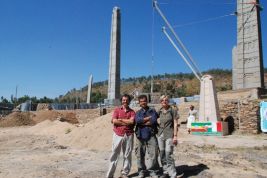
The “Italian” obelisk…
As we arrive here, works have just been completed on an obelisk that up until 2005 could be seen in Rome; now, it has been brought back to Ethiopia.
The head of works explains to us the delicate operation of flying it here and then loading it onto a truck and then finally erecting it on its original site; work lasted three years.
In 1937, permission was given by the Ethiopian King for the obelisk that had been lying on the ground, broken into four pieces for centuries, to be taken to Italy where it was restored. Unfortunately, no trace of the permission granted for its removal could be verified and in accordance with international pacts, it has been brought back to its original place, were it stood seventeen-hundred years ago.
A sea of red powder
A hands breadth deep with compacted large, sharp stones the size of your fist.
This rocky and hard beaten earth road is the road that leads to Axum in Gonder. There are many hairpin bends and corners as we climb and then descend these seemingly endless and spectacular mountains.
This is another Italian contribution from1940; imagine the difficulties making this road back then. You have to admire those who planned, calculated and laid out the plans, and lest we forget the hands of those who broke and laid all the stones.
It is a truly extraordinary, a work of art, especially if you think of the tools, problems and means of transport of the time.
In the distance we see the spectacular Simien Mountain that reaches the highest point in the country: 4543metres.
The forests are full of Gelata baboons with their red chests; typical of Ethiopia.
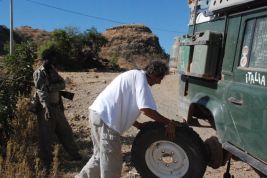
We have filled up our water tanks and seeing that naphtha can be difficult to find here, we fill right up to the brim, this makes for a heavy feel to the vehicle.
The load is noticeable and on these roads the front tyres can suffer and are always at risk.
Occasionally we are let down.
With armed spectators…
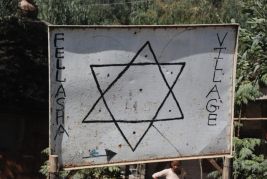
Wolleka Village
The inhabitants of this village have always worshiped and celebrated rituals familiar to those of the Hebrews. Before the Christians arrived, the old religion of this land was Jewish. As a consequence, this place has remained like an island of the old traditional Hebrew religion and its followers are nicknamed Fellasha.
Many Israeli theologists and experts have come here to understand the correlation between this black population and the Jews.
Confirmation of this led to an exodus between 1985 and 1991 towards Israel, who then had to deal with all the logistics of its new visitors exploring this new frontier.
A good film that we recommend portrays and helps to understand this time in Ethiopian history - “Live and Become” by Radu Mihaileanu.
Here are two lovely faces of a mother and a girl; the mother sells things to tourists along the Tana Lake, whilst the girl looks after the sheep in the Tigraqi Mountains

Gonder – 17 Dec 2008
The thing that strikes many Italians who enter this city, are the number of houses and buildings built in the art deco style of the fascist period. Walking along the main streets, we get a strange sense of “home” and a familiar feeling that we know the place.
We lodge in the comfortable and clean Belegez; nearby a castle and the centre.
You can also camp but the low cost of the room (80 bir = 6 £/euro) make us choose the comfort option.
GPS N12°36,634 E37°28,316’
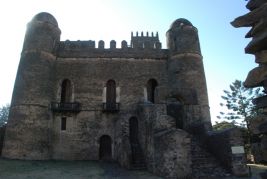
Gonder, often nicknamed the African Camelot is not what it is famous for.
Since 1636 and for two centuries, the rulers have made her the capital, transforming the city into a powerful and flourishing centre. They have built castles, palaces, stables, banquet rooms, music houses and Turkish baths.
The plots, assassinations, courtiers and the magnificence of the court are worthy of the best medieval traditions.

Kate and Tara centre
Originally English, she is married to an Ethiopian and together they live in this support centre that they founded. They have countless initiatives helping children, the old and poor families.
We leave some clothes and n Elfo token.
(Details in solidarity).
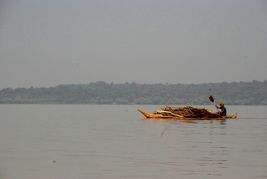
Lake Tana – 19 Dec 2008
This lake is huge, with islands and monasteries. The low water in this season is the colour of mud but there are certain times during the year when it is an intense colour of blue. Straw pirogues carry precious wood across the lake. During the recent war with Eritrea, some chemical weapons were used resulting in the absence of trees growing in certain areas; their wood is indispensible and used here for cooking.
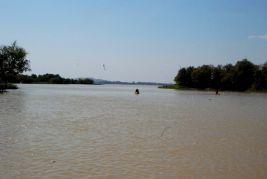
Blue Nile
From this lake the Blue Nile begins its journey flowing out were it will eventually become tributary to the White Nile that started its journey in Uganda. Along its route it gathers fertile compost that makes up three quarters of the “silt” that brings life to the banks in Sudan and Egypt.
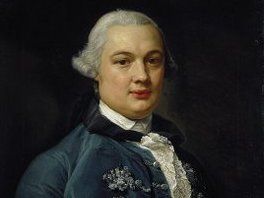
James Bruce - The Imposter
Born in Scotland, he was British consul at Algiers for a few years, leaving in 1768 looking for the source of the Nile. He arrived in the Gonder court where he became the emperor’s right hand man.
In 1770 he declared to have come up with the solution for his quest, he omitted to tell what the Spanish Jesuit, Pedro Paez had already discovered 150 years before him. It is alleged that Bruce knew of this but nevertheless, in 1790, he wrote an account of a journey that saw him honoured amongst those more superficial people whilst the more educated scorned in disbelief, him and those credulous people who exaggerated the credibility of his stories.
However, the problem of the source of the Nile hadn’t been completely resolved, because this river connected to the White Nile that had more remote origins that were still unknown. (It was resolved 100 years later in 1862 by Speke as we already discovered in Uganda).

Cascades of the Blue Nile
One time these were extremely powerful and spectacular 400-metre falls. Now, a damn for the production of electricity has reduced them to a width of just 4-metres. We were lucky to catch them, as the dam was opened, making for a much better spectacle.
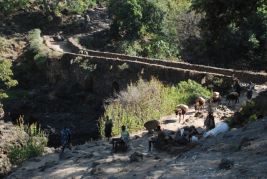
Portuguese Bridge
A scene from medieval times, this bridge was built by the Portuguese in 1600 and crossed using donkeys laden with goods. (What were the Portuguese doing here?)
It straddles the old course the river took before it was deviated by the Blue Nile dam.
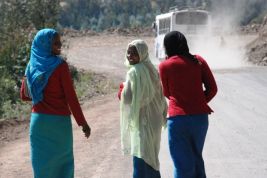
Exit – 20 Dec 2008
The nearly 200km of track heading towards Sudan is in great condition; however, there are many road-works but very soon it will all be asphalted. At the border, we are stopped by customs and immigration. There’s no need to stamp the Carnet as some have told us. Within minutes we are out of the country.
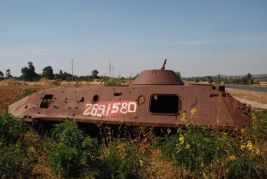
Our Impressions
That there has been a change since Kenya is very apparent. Ethiopia isn’t like any country in black Africa or in Arab Africa. A particular calendar to itself; a particular time measure to itself; an alphabet used only here. It is rich in history and has monuments that date from 300AD to modern times. The food is interesting and to be discovered - the injiera, ouzo (aniseed liquor) and the coffee with its elaborate ceremony.
The scenery is amazing, but often the countryside is dirty and tatty.

The people are very poor but have great sense of hospitality, usually very cordial. Few speak English. Everybody asks this though: Birr, birr. Yu yu… especially the children. They ask it everywhere; along the road, in the city, in the tourist places and not. Unfortunately they have a habit of stoning everything, especially cars. One has to avoid them by looking carefully as you pass bye. Waving hello to them with a huge smile and saying “no, no” whilst wagging your finger, usually gets them to “disarm”.
We were only thrown at five times and they were only little children. Once, as we passed through a village, a mad lady in rags took hold of a huge stone when she saw us and was about to throw it against the windscreen.
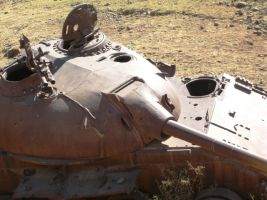
We wish for a future with more freedom for this beautiful land and its lovely people. And were the efforts of its government are less directed towards weapons and more to the development of the country; especially in the north, where the extreme arid conditions pose many problems. The people have no food despite receiving tons of humanitarian help which is partially requisitioned and sold on the black market. All this help despite being indispensable, has created a terrible dependence for it, it has destroyed individual awareness, inducing a population into not making an effort to better their own state but to simply wait for handouts from the west. Emergency, by nature will not carry on forever.
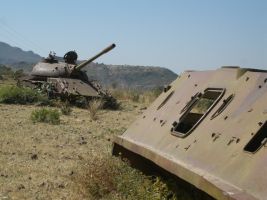
There is a State presence almost everywhere; undercover plain-clothes police and spies. The people don’t enjoy talking about politics. Recently, a singer/songwriter has been arrested against accusations of an alleged murder in a car, the date of which corresponds to a day when he was actually touring abroad, but the evidence and the reports say otherwise; it seems the government are averse to the messages in his songs.
All the ONGs are observed and controlled. Telecommunications in the country are very primitive; rarely do mobile phones work, even with a full signal. To find a sim card with number isn’t an easy task. They're too expensive for most people: 30 £/euro. In the rest of Africa we were able to buy top-ups for 1 £/euro.
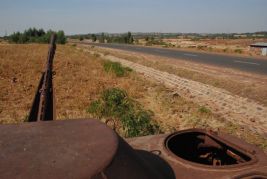
As we draw nearer to the north border or just simply change city, our phone cards are blocked and they don’t work for a whole week. The Internet often doesn’t work and when it does, it is eternally slow. Many websites are blocked, for example, the ones that have blogs and all the communication programs like Skype are closed. All post is read and so generally, nobody receives any.
Many billions are spent on weapons. At the moment there are many troops in Somalia, officially, they are there to defend the Christians from the Muslims. Strange then, that there appears to be no Christians in Somalia.
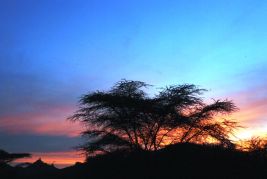
Pointing towards her with our car, as if we were going to run her over and beeping the horn, she thankfully left the stone and moved out of our way.
The main roads, except the ones in the north of the country are generally in good condition.
There are many Chinese run roadworks. Off the beaten track, the roads are quite punishing on your tyres. All the roads are invaded by sheep, cows, donkeys, carts, goats and farmers that beat the wheat (especially on the asphalt that is nice and smooth).
The police have been absolutely great with us; we have never been stopped on the road; however, this is not the case for the people that live here.
